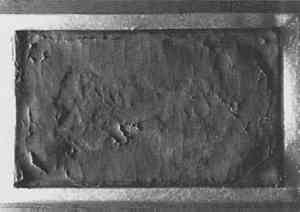FROM THE GROUND UP: THE GROUND IN 19TH-CENTURY AMERICAN PICTURESJOYCE ZUCKER
3 WATER-SOLUBLE GROUNDSChurch's 1847 painting Christian on the Borders of the Valley of the Shadow of Death(fig. 18) has suffered much due to the water-soluble nature of its ground. The picture was subjected to a double Elmer's Glue lining in 1965. Its removal and subsequent wax relining did not solve the structural problems, for the ground literally dissolves when water is applied to its surface. The application of a water-based lining adhesive compromised the structure even further. The minimal amount of water that seeped through the back of the fabric was enough to cause additional breakup of the ground. There was a lack of adhesion between paint and ground and between ground and canvas. The paint sat like corn flake crumbs over large areas of the surface. During the removal of the Elmer's Glue lining in the 1980s, a Theodore Kelley canvas stencil was found on the reverse and noted in the conservator's report. In the year Church painted Christian, Theodore Kelley was located on Wooster Street in lower Manhattan (Katlan 1987). His primings are notorious for their water-soluble nature. The painting was recently re-treated using local consolidation.
Artists who used absorbent grounds like the calcium carbonate–animal glue combination found in Theodore Kelley canvases may well have been seeking a bright, fresco-like appearance. Unfortunately, the chalk ground is highly susceptible to the action of water. When Church's oil sketch for The Icebergs was subjected to harsh treatment, including the use of water-based adhesive in the 1960s, the result was severe cleavage between ground and canvas and between paint and ground (fig. 19). The restorer felt compelled to extensively overpaint the accompanying loss.
While the two previous examples come from the works of Church, many other artists were interested in achieving the light, bright appearance possible with absorbent grounds. Many of them also purchased supplies from Theodore Kelley, including Durand and Gifford (Katlan 1987). In the past, paintings with water-soluble grounds were often infused with wax before cleaning was undertaken. There is a need to look for alternative methods for treating these precarious structures. Before treating 19th-century American paintings, it is critical to know the structure well. Not only the resinous components in the layered structure, but also the ground can become solublized. Chalk grounds or partial chalk grounds are also implicated when we see severe shrinkage and loss in a painting (fig. 20). Note the tendency of this painting to shrink in areas exposed to water. A high percentage of calcium carbonate and animal glue is often found in the ground layers of pictures that have a tendency to shrink. Hedley had conducted research on “shrinkers,” according to Carlyle (1990). Carlyle noted that Hedley's preliminary findings suggested that power-loomed fabrics were implicated.
|


